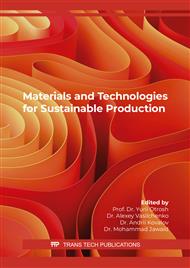[1]
KARECHE, A., Etude des matériaux à base de bois de palmier dattier-durabilité, Dégradation et propriétés structurales et de transfert, Mémoire de magister, Faculté de technologie, Université El-Hadj lakhdar (Algérie), (2014).
DOI: 10.22453/lsj-020.2.300-322
Google Scholar
[2]
BENMANSOUR, N., Etude des performances de produits renouvelables et locaux adaptés raux applications de l'isolation thermique dans le bâtiment, Mémoire de magister, Faculté des sciences, Université El Hadj Lakhdar (Algérie), (2011).
DOI: 10.22453/lsj-020.2.300-322
Google Scholar
[3]
ALAOUI, S. B., Référentiel pour la Conduite Technique du palmier dattier, In Référentiel de Conduite Technique des Principales Cultures au Maroc,, Éditeurs: Si Bennasseur Alaoui et AjiroYasuhei, 2005, pp.102-112.
Google Scholar
[4]
K.H. Mo, et al., Green concrete partially comprised of farming waste residues: a review. Journal of Cleaner Production. 117 (2016), p.122138.10.1016/j.jclepro.2 016.01.022.
DOI: 10.1016/j.jclepro.2016.01.022
Google Scholar
[5]
J. Claramunt, et al., The hornification of vegetable fibers to improve the durability of cement mortar composites, Cement and Concrete Composites, 33(5) (2011), pp.586-595.10.1016/j.cemconcomp.2011.03.003.
DOI: 10.1016/j.cemconcomp.2011.03.003
Google Scholar
[6]
A. Kriker, et al., Mechanical properties of date palm fibres and concrete reinforced with date palm fibres in hot-dry climate, Cement and Concrete Composites. 27(5) (2005), pp.554-564.10.1016/j.cemconcomp.2004.09.015.
DOI: 10.1016/j.cemconcomp.2004.09.015
Google Scholar
[7]
S. Abani, et al., Valorisation of Date Palm Fibres in Sahara Constructions. Energy Procedia, 74 (2015), pp.289-293.10.1016/j.egypro.2015.07.60.
DOI: 10.1016/j.egypro.2015.07.608
Google Scholar
[8]
A. Makhroufi, Contribute to the study of the properties of palm fiber concrete in the dry and warm areas, in Department of Irrigation and Civil Engineering, 2004, Kasdi Merbah University of Ouargla.
Google Scholar
[9]
Abani, s., a. Kriker, and a. Bali, effect of curing and mix design types on performance of date palm fibres reinforcement concrete under hot dry environment, in 11th int, Inorganic- bonded fiber composites conference (iibfcc): madrid, spain, 2008, Pp. 254-259.
DOI: 10.1016/j.cemconcomp.2007.11.006
Google Scholar
[10]
CHARLET, K., BALEY, C., MORVAN, C., JERNOT, J.P., GOMINA, M, et BREARD,J., Characteristics of Hermès flax fibres as a function of their location in the stem and properties of the derived unidirectional composites, Composites Part A: Applied Science and Manufacturing 38, 2007, pp.1912-1921.
DOI: 10.1016/j.compositesa.2007.03.006
Google Scholar
[11]
AZIZ, M. A., PARAMASIVAM, P, et S. L. LEE., Prospects for natural fibre reinforced concretes in construction, International Journal of Cement Composites and Lightweight Concrete 3, 1981, pp.123-132.
DOI: 10.1016/0262-5075(81)90006-3
Google Scholar
[12]
BEN AMMAR, B K., Mezghiche, B., L'effet de l'étuvage par énergie renouvelable sur la résistance à la compression des bétons, Congrès Algérien de Mécanique, 26-30 novembre, Constantine, Algérie, (2017).
Google Scholar


